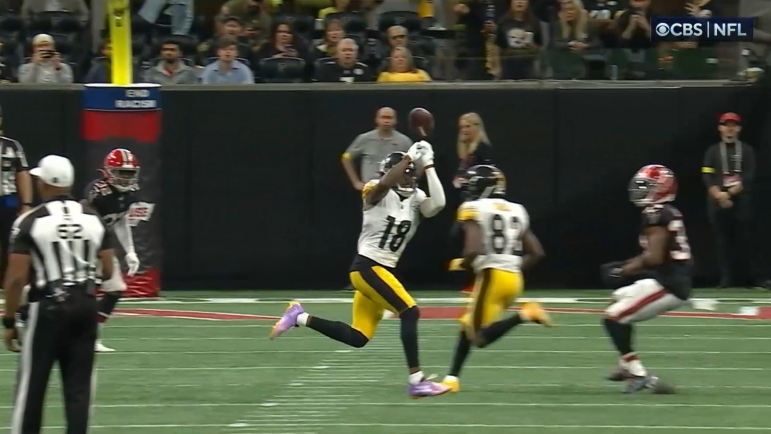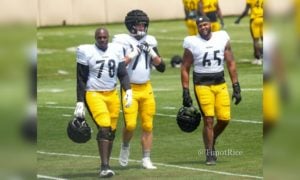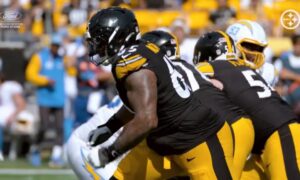It’s no secret that Pittsburgh Steelers veteran wide receiver Diontae Johnson has issues with catching the football consistently at times.
Coming off of a rather difficult season in which he set the all-time mark in league history for receptions without a touchdown just a few months after signing a lucrative two-year extension with the Steelers, the focus remains on Johnson entering the 2023 season.
Can he be a true No. 1 or No. 2 type in Pittsburgh? Is he worth the $18 million a year he’ll get the next two seasons, making him the 16th-highest paid wide receiver in football? The answers to those questions should be a resounding yes, but depending on who you ask and what you hear about Johnson, he’s not a clutch receiver, drops the football in key spots and just doesn’t make the big plays overall.
So, of course, I had to dive into the tape and really try to contextualize Johnson’s drop and look at when they came within the game, regarding down, distance, situation on the scoreboard, etc.
According to Pro Football Reference, Johnson was charged with seven drops on the season. However, Pro Football Focus had Johnson charged with eight drops. Based on the drops per game in the game logs on both sites, drops occurred in different games too, so there’s no concrete info to go off of for either one.
That led me to look at all 147 targets Johnson had in 2022, on which he finished with 86 catches for 882 yards. Of those 86 catches, 45 (52.3%) went for first downs, which put him around the league average in percentage of receptions going for first downs Below, I’ll take a look at 11 drops that occurred during the season, since PFR and PFF didn’t have the same number of drops, and didn’t have the all of the same games in which Johnson was charged with a drop.
A drop is a subjective stat, so let’s go through them and determine if Johnson failed to make plays in key situations, like the popular nonsense going around regarding him is.
Starting in Week 1, Pro Football Reference charged Johnson with a drop. Pro Football Focus did not. Here’s the situation:
OT — 1st and 10, ball at the Cincinnati 45, game tied 20-20, 25 seconds left in overtime.
Simple slant route from Johnson, who is aligned out wide outside the number. Plenty of space there to operate in the middle, but the throw from Mitch Trubisky is a bit high and off the mark.
However, it does hit Johnson’s hands in stride, so I can see why PFR labeled it a drop. Still, that’s a drop on first down and ultimately didn’t cost the Steelers in the end, as three plays later the Steelers kicked the game-winning field goal. If Johnson makes that catch it’s unlikely he’s creating any YAC after that, so it stopped the clock in the end and got the Steelers in a bit of a better play overall as the next play was a 10-yard completion to tight end Pat Freiermuth, setting the Steelers up at the Cincinnati 35.
Two weeks later, Johnson was charged with a drop from PFF against the Cleveland Browns on the road in Week 3. PFR did not label it a drop. Here’s the situation:
Q3 — 3rd and 3, ball on the Pittsburgh 32, Steelers trailing Browns 16-14, 1:21 left in the third quarter.
This one is absolutely a drop from Johnson, and it’s a bit of a surprise that PFR didn’t label it one.
While Cleveland cornerback Denzel Ward had his hand inside of Johnson’s, it’s a play that a WR1 has to make. That was arguably Trubisky’s best ball of the night. It was an absolute dime in stride late in a game in which the Steelers offense was struggling.
That’s the type of play the Steelers paid Johnson to make, and he came up small in that situation. Definitely a crucial drop as the Steelers gave up a touchdown on the next Cleveland drive, falling behind 23-14 in an eventual 29-17 loss.
Week 4 against the New York Jets led to a drop from Johnson, according to PFR’s tracking. Of course, PFF didn’t give Johnson a drop for it. Here’s the situation on the drop against the Jets:
Q1 — 1st and 10, ball on the Pittsburgh 23, game tied 0-0, 7:35 left in the first quarter.
Right through the hands, leading to an interception from LaMarcus Joyner off the deflection.
Johnson got up claiming the ball was tipped, but it very clearly went right through his two hands on the slant route in which he was wide open. Sometimes the ball can be tipped and change trajectory some, but the ball shouldn’t be going through his hands like that.
Though the drop occurred on first down early in a game tied at 0-0, it’s a key drop that led directly to a Jets’ field goal and a 3-0 lead in the first quarter. Concentration drops are an issue for Johnson, and that’s exactly what this one seemed to be.
One week later, Johnson recorded a drop against the Bills, which was charge to him by PFF, but not PFR. That’s how this research went early on. One site gave him a drop, the other didn’t. Rather frustrating, but shows just how subjective drops are.
Here’s the situation against the Bills in Week 5, leading to Johnson’s drop:
Q1 — 3rd and 6, ball on the Pittsburgh 29, Steelers trailing Buffalo 10-3, 55 seconds left in the first quarter.
This might be Johnson’s worst drop of the season. Third down, rookie quarterback Kenny Pickett, in his first career start, scrambling looking to make a play, Johnson wide open in space, and the ball goes right through his hands and is nearly intercepted.
That’s a play any receiver in the NFL should make. It’s not that difficult of a play, outside of the leap to get up to make the catch. He has no contact at the catch point and has all kind of space to make a play after the catch. Instead, it’s a painful drop in an early-season stretch of struggles from Johnson.
Week 7 against the Miami Dolphins led to another drop from Johnson. This one on Sunday Night Football was charged to him by PFF, while PFR did not count it as a drop.
Here’s the situation with the drop against the Dolphins:
Q3 — 1st and 10, ball on the Pittsburgh 15, Steelers trailing 16-10 with 8:37 left in the third quarter.
It’s largely an inconsequential drop, considering it occurred on first down, but it again shows the concentration issues Johnson has at times on the simplest of catches. That’s right in the breadbasket, a catch we see receivers make constantly in the NFL.
For whatever reason, Johnson drops it. Of course, that’s only going for a gain of a few years, maybe 6 or 7, but still that’s a successful play on first down in a game in which the Steelers are trailing. Not exactly a clutch moment, by definition, but a very frustrating drop nonetheless.
After this drop against the Dolphins, Johnson went five weeks without a drop, both from PFR and PFF’s metrics.
In Week 12 though against the Indianapolis Colts on Monday Night Football, PFF charged Johnson with a drop, while PFR didn’t.
Here’s the situation against the Colts:
Q4 — 2nd and 2, ball on the Indianapolis 2, game tied at 17-17 with 10:02 left in the game.
This drop is definitely one I would consider Johnson failing to come up “clutch” for the Steelers. Tie game, ball on the 2 yard line, he wins the route cleanly and has a perfectly-thrown football from Pickett hit him square in the hands. He can’t make the play.
Granted, the Colts’ defensive back gets involved late to try and disrupt, but Johnson has to finish that play, especially knowing the situation. That’s what he’s paid for. That’s why they called that route in that area for him.
Fortunately for the Steelers, Benny Snell Jr. scored on the next play on a 2-yard run, giving the Steelers a 24-17 lead that they’d eventually hold onto for the win, but this is one of those plays Johnson wishes he could have back, especially after finishing the season without a touchdown.
Week 13 against the Atlanta Falcons brought two drops for Johnson, based on PFR’s charting, while PFF only charged him with one drop.
Here’s the situation on the first drop against the Falcons:
Q2 — 3rd and 11, ball on the Atlanta 28, Steelers winning 3-0 with 13:43 left in the second quarter.
This one, right alongside the drop against Buffalo, are the two biggest ones from Johnson this past season, at least in this writer’s opinion.
Third and 11, wide open on a crossing route with nothing but green turf in front of him, and Johnson comes up with a crucial concentration drop in a big spot. He could feel the space around him and was thinking about what he was going to do after the catch, rather than securing the catch first.
Too often that happens with Johnson.
Later in the game, Johnson was charge with a second drop.
Q3 — 2nd and 13, ball on the Atlanta 17, Steelers leading 19-6 with 5:38 left in the third quarter.
Again, great route here by Johnson to win cleanly off the line of scrimmage and create separation. Terrific throw to the back corner by Pickett. Johnson just doesn’t complete the play.
Yes, Atlanta cornerback A.J. Terrell got involved late to help force the drop, but Johnson has to make these plays. I hate sounding like a broken record, but that’s why he’s paid the money he is and is targeted as much as he is. The Steelers view him as a No. 1 type and believe in him in these situations. He has to start rewarding them.
After the two-drop performance against the Falcons, Johnson didn’t record another drop until Week 16 against the Las Vegas Raiders on Christmas Eve, which was charted as a drop by both PFR and PFF.
Q3 — 1st and 10, ball on Pittsburgh 29, Steelers trailing 10-3 with 4:40 left in the third quarter.
Slant route — again. Wide open, ball goes right through his hands.
In traffic Johnson tends to have more concentration drops than normal. Maybe he’s worried about the hit that could be coming and is more focused on getting his eyes downfield and making a move. Whatever it is, he has to clean it up. Far too often the ball went right through his hands.
It just simply cannot happen.
Finally, in the season finale against the Browns, Johnson had a rather rough day catching the football.
According to charting from PFF and PFR, Johnson was charged with two drops. The first came on his first target of the game and portrayed just how rough of a day it would be for the standout receiver.
Q1 – 1st and 10, ball on the Cleveland 36, game tied 0-0 with 9:20 left in the first quarter.
This is a straight up concentration drop from Johnson. It’s an easy speed out designed for him to get outside and catch a short pass from Pickett to get into the game with some rhythm.
Instead, the ball clangs right off of his hands. Notice he’s trying to get his head around to find the defenders closing in, rather than securing the football first? It’s a consistent issue within his game. It has been since his time in college at Toledo.
Later in the first half, Johnson again had a drop. They didn’t call the fumble-eventually-ruled-incomplete play a drop, but this one was.
Q2 — 1st and 10, ball on the Pittsburgh 44, game tied 7-7 with 1:11 left in the first half.
Johnson does a great job at the top of his route creating separation against the defensive back, but with the throw being slightly high, Johnson has to go a bit out side of his comfort zone to go up and try to get it. The ball hits him squarely in the hands, but as he’s coming to the ground he flat-out drops it.
Just an ugly rep on a tough day for Johnson.
Now that we’ve examined all of the drops charted by PFF and PFR, here’s the breakdown of drops based on downs:
1st down — six drops (one in the end zone)
2nd down – two drops (one in the end zone)
3rd down — three drops (none in the end zone)
4th down — zero drops
Of the 11 drops, eight occurred on first or second down, with just two occurring in the end zone. Only three occurred on third down, which flies right in the face in the believe and narrative passed around on social media that Johnson isn’t clutch and constantly drops the ball on third down.
Make no mistake about it: Johnson has to clean up the concentration drops. He can make the spectacular catches looks easy; it’s the simple catches he really struggles with.
He’s still a high-level player, one that separates at an elite level and is targeted like a true No. 1. The drops are frustrating, but they are correctable with improved concentration. Sometimes Johnson just needs to get back to the basics in these situations.








